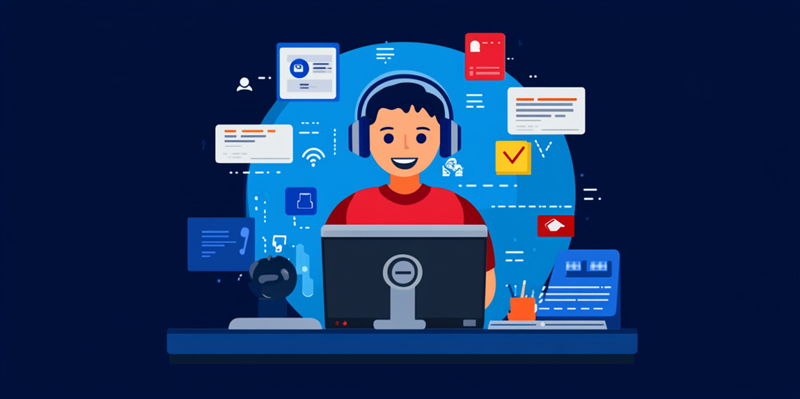In an increasingly digitalized world, businesses face the challenge of adapting their customer service strategies to meet evolving consumer expectations. Exemplified by Tony Hsieh’s decision to personalize Zappos’ customer service, it’s clear that integrating digital customer service (DCS) can significantly enhance satisfaction and loyalty among customers. This article delves into the dynamics of digital customer service, exploring key channels and offering strategies for businesses to excel.
Digital customer service leverages various online touchpoints to interact with customers, answering their questions, resolving issues, and handling complaints. Despite the shift from traditional to digital platforms, the ultimate goals remain the same: improving customer satisfaction and fostering brand loyalty by effectively addressing customer concerns. The need for businesses to adapt to this digital shift is more crucial than ever, as consumers increasingly expect immediate, personalized responses to their inquiries.
Key Digital Customer Service Channels
Several channels contribute to a robust digital customer service strategy. Each channel has its benefits and challenges, suiting different aspects of customer service needs.
Chatbots are among the most efficient tools in digital customer service. These AI-powered virtual assistants simulate human conversation and can handle tasks such as order fulfillment and processing returns. Their cost-effectiveness and efficiency have made them extremely popular, with 88% of customers reported using them by 2022. Despite these advantages, chatbots are generally best suited for handling basic queries. They may fall short when it comes to resolving complex or emotionally charged issues, where human intervention becomes crucial.
On the other hand, Live Chat connects customers with real human agents, providing a personal touch that chatbots cannot offer. This channel is highly effective for addressing complex issues and tends to yield higher satisfaction rates. Customers appreciate the personalized assistance, which often leads to more effective problem resolution. However, the downside is that live chat is slower and more costly compared to automated solutions like chatbots, requiring businesses to employ and train human agents rigorously.
Social Media platforms have become modern-day complaint boards for consumers due to their accessibility and immediate visibility. Many customers find it straightforward to voice their concerns on platforms like Twitter, Facebook, and Instagram. Businesses can implement automated replies to handle common questions swiftly. However, personalized responses are crucial in this setting to make customers feel truly acknowledged and valued. A well-handled complaint on social media can turn a dissatisfied customer into a loyal brand advocate.
Email remains one of the most reliable channels for customer support. Companies that invest in this method often see a 20% higher ROI, making it a worthwhile component of a broader customer service strategy. Despite its reliability, email communication can be slower and may come with higher staffing costs due to limited operating hours. Nonetheless, it serves as a detailed and formal medium, suitable for addressing more complex inquiries or providing comprehensive solutions.
Online FAQ Pages serve as an invaluable self-service tool, allowing customers to find answers to common questions on their own. These pages can significantly reduce the strain on human customer service agents by addressing routine issues. A well-structured and easily navigable FAQ section can prevent minor issues from escalating, thereby enhancing customer satisfaction and efficiency in resolving inquiries.
Tips for High-Quality Digital Customer Service
Successfully navigating the digital customer service landscape necessitates strategic planning. Here are several tips for optimizing your approach:
Employing an Omnichannel Approach is crucial for catering to different customer preferences. Younger consumers are more likely to prefer self-service options, while older customers may favor human interaction. Offering a variety of touchpoints ensures broader accessibility and convenience for the entire customer base. An omnichannel approach increases the likelihood that customers will find a channel they are comfortable using, thus improving their overall experience and satisfaction.
Identifying Your Audience is pivotal for any business looking to optimize its digital customer service. Using a customer relationship management (CRM) platform helps gather critical data about your customer base, which can then be used to tailor services to their specific needs. This data-driven approach enables businesses to offer more personalized and effective support, which enhances overall customer satisfaction and loyalty.
Being Personal in Your Communications can make a lasting positive impression on customers. Even within automated systems like chatbots, small personal touches can make interactions more enjoyable. Personalized follow-up communications can distinguish your business in a landscape full of generic, self-service options. This level of attention to detail can turn a one-time shopper into a long-term loyal customer.
Emphasizing Customer Convenience is another vital strategy. Low-effort solutions, such as a well-organized FAQ page or easy-to-access chatbots, can address issues swiftly and reduce customer frustration. The easier it is for customers to find solutions, the more satisfied they will be. Convenience is a significant factor in modern customer satisfaction and can be a decisive element in a customer’s choice to stick with or abandon a brand.
Asking for Feedback is critical for continuous improvement. Collecting and analyzing feedback through surveys and automated rating systems helps identify the strengths and weaknesses of your customer service strategy. Understanding what works and what doesn’t allows businesses to make necessary adjustments and improve their service offerings continually.
Closing the Loop with customers after resolving their issues not only ensures their satisfaction but also provides another opportunity for a personalized connection. This practice helps solidify customer loyalty by showing that the business genuinely cares about resolving issues satisfactorily and values its customers’ opinions. Following up can turn a neutral or even negative experience into a positive one.
By aligning digital customer service strategies with customer expectations and leveraging a mix of human and self-service touchpoints, businesses can significantly boost customer satisfaction and loyalty. The integration of AI-powered tools alongside human intervention allows for a balanced approach, catering to an array of customer needs and preferences. Employing these tips and tools, businesses can create a seamless, efficient, and satisfying customer experience.

